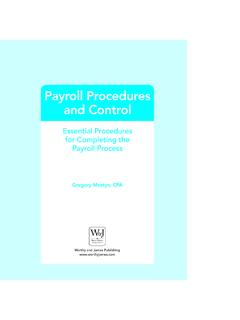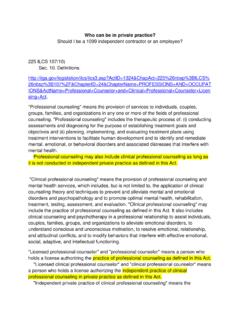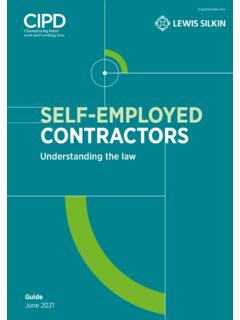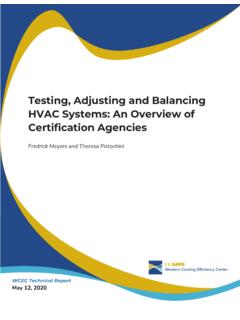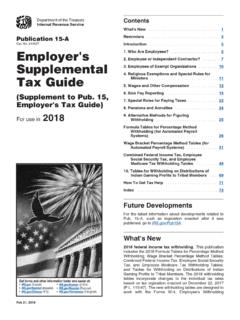Transcription of Payroll Procedures and Control - Worthy & James
1 Payroll Procedures and Control Essential Procedures for Completing the Payroll Process Gregory Mostyn, CPA Worthy and James Payroll Procedures and Control Essential Procedures for Completing the Payroll Process Published by Worthy and James Publishing To view our publications and other content, go to: < > Te r m s o f Use This material is copyrighted. 2008 Worthy and James Publishing. All rightsreserved. No part of this work may be reproduced, transmitted, or used in any otherform or by any means electronic or mechanical including photocopying, Internetdistribution, or any other manner without the written permission of the publisherexcept as is permitted by Federal copyright law. If you use this material, then you understand and agree to these terms of use:Wa rning - Disclaimer: If you decide to use this material, then you agree that this mate-rial is designed and intended to provide you only general educational instruction inaccounting principles.
2 This material is sold with the understanding that the author andpublisher are not engaged in providing accounting, financial, tax, legal, or any othertype of professional services. If professional services are needed, competent professionaladvice should be obtained. Although every effort has been made to make this material asrelevant, useful, and accurate as possible up to the date of publication, the material maycontain errors and omissions. The author and publisher make no guarantees or warran-ties, express or implied, and shall have neither liability nor responsibility, even if advisedof such possibility, for any loss or damage caused or alleged to be caused, directly orindirectly, by use of this material. If you do not agree to these conditions you may returnthis special report immediately upon purchase for a full the exception of companies and organizations whose identities as actual entitiesare made clear within the context of the text discussion, all persons, organizations,and entities in this material, including in illustrations and Practice, are completely fic-tional.
3 Any resemblance to actual persons, organizations, or entities, past or present, ispurely coincidental. iii Ta ble of Contents 2008 Worthy and James Publishing. See front matter: Terms of Use. What is Payroll ? ..1 Getting Help ..1 Diagram of the Payroll Process..2 Employees ..3 independent Contractors ..4 Statutory Employees..5 employee Identification and Internal Control ..5 Gross Pay ..8 Income Tax Withholding ..10 Social Security (FICA) Withholding..12 Other Withholding ..14 Employer Payroll Taxes ..16 Employer Benefits Expenses ..19 Recording the Payroll : The Payroll Register ..22 Recording the Payroll : Journal Entries ..24 Recording the Payroll : employee Earnings Records ..25 Making Payments ..28 Submitting Forms and Reports..32 Financial Statement Presentation and Accruals ..34 Quick Review and Vocabulary.
4 36 Practice Questions and Problems..38 Solutions to Questions and Problems .. 49 Payroll Procedures and Control 1 2008 Worthy and James Publishing. See front matter: Terms of Use. Overview of Payroll What Is Payroll ? The term Payroll generally refers to the process of identifying employees,calculating the pay and Payroll taxes, recording the Payroll transactions,making the payments, and completing required federal and state payrolltax forms. The diagram on the next page shows you an overview of the process. Legal Rules Payroll is unique from other basic accounting topics because payrollinvolves many federal (and state) Payroll tax and income tax withholdinglaws, and pay rate calculation rules. Each of these legal rules imposes dif-ferent requirements. So, to understand the Payroll process, you will findyourself learning more than just how to properly analyze and recordtransactions.
5 You will also learn about Payroll laws and what is required tocomply with these laws. Because each state has its own Payroll laws, we focus on federal Payroll requirements. Getting Help This material provides a general description of the Payroll process. If youneed to understand more about federal and state Payroll laws and compli-ance requirements, or to calculate a Payroll , you will need more help. Hereare some suggestions for where to find more detailed information: Circular E: (Publication 15) This is a comprehensive employerresource for federal Payroll rules. You can find it at the Internal Reve-nue Service website ( and for ftp users) and youcan also order it from the Internal Revenue Service Forms and Publica-tions department by calling a local Internal Revenue Service office.
6 State Information: With access to the Internet, you can quickly findstate Payroll references in several ways, including: (1) You can do anInternet search for state of (name of state) Payroll tax. (2) As of thiswriting, some useful websites are and the AmericanPayroll Association site. (3) Use the reference section of a library. Professional Help: If you are in business or going into business, you must obtain expert professional help, because rates change and lawschange and can be complex to apply. Find a CPA or an attorney whoalready has clients in the same type of business that you are in and whois familiar with your type of Payroll and business issues. Interview severalprospects, get client references, and double-check with state licensing boards.
7 Payroll 2 Payroll Procedures and Control 2008 Worthy and James Publishing. See front matter: Terms of Payroll ProcessIdentify Employees employee vs. independent contractor Statutory employeeCalculate the Payroll Gross pay and withholding Payroll taxes expense Benefits expenseMake Payments To employees To taxing authorities To other partiesRecord the Payroll Journal entry for the gross pay expense Journal entry for the Payroll taxes expense Journal entry for the benefits expenseSubmit Forms and Reports Federal government State government Employees and contractors Payroll Procedures and Control 3 2008 Worthy and James Publishing. See front matter: Terms of Use. Employees Overview Not all people who perform duties for a business are employees. It is veryimportant to accurately identify which workers qualify as employees becausethe law imposes different requirements for workers who are employees andthose who are not.
8 Every business must comply with the requirements of these laws. Proper identification also reduces fraud and waste. employee Defined The general rule (called common law ) is that any person who performsservices for a business is an employee if the business controls : what will be done, and how it will doneThis definition must be applied to each individual. It makes no differencewhat job title or name is used, how the individual is paid, or whether thework is full time or part time. Note: A business can submit Form SS-8 to have the Internal RevenueService determine employee status. Contact state employment offices for state rules. Example of an employee Jane is a secretary at Smith Company and is given word-processing tasksto perform that include preparing management reports.
9 Jane is expectedto be at the business during certain hours and allow her manager to reviewand make changes in her work. She must use the business office and thecomputer equipment and word-processing software used by the is an employee because the Smith Company supervises and controls how the job is done. Not an employee Mary also performs the same type of services for Smith Company. Mary isgiven a management report to complete, and she completes the job fromher own office, which is not at the Smith Company location. Mary usesher own equipment and software, and she completes the job during herown hours without review from Smith managers. Mary is not anemployee because Smith Company does not supervise or Control how the job is done. continued Identify Employees 4 Payroll Procedures and Control 2008 Worthy and James Publishing.
10 See front matter: Terms of Use. Employees , continued Business Owners Proprietorships: A sole proprietor is never an employee of the business. Partnership: A partner performing duties as a partner is never anemployee of the partnership. Corporations: Owners (shareholders) of a corporation who work in the business are employees of the corporation. independent Contractors Overview It is important to identify independent contractors, because an indepen-dent contractor is not an employee , even though the independent contrac-tor may do the same kind of work as an employee . The documentationand compliance rules that a business must follow for independent con-tractors are very different than for employees, so the distinction is signifi- cant. Only employees are considered to be part of a business Payroll .
